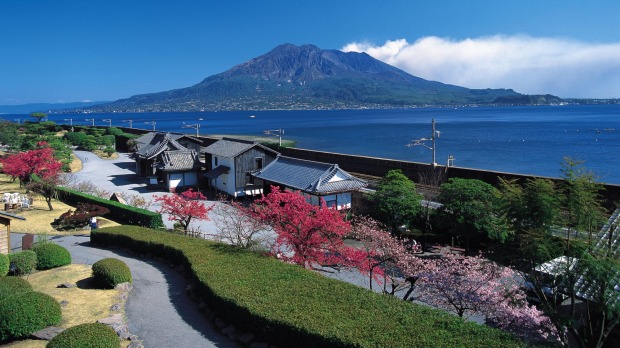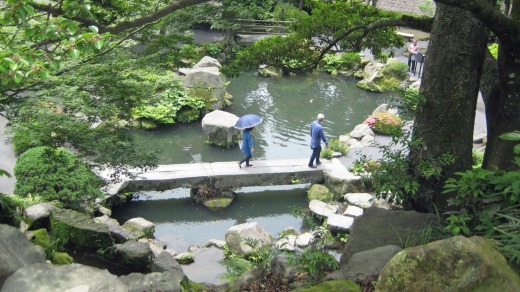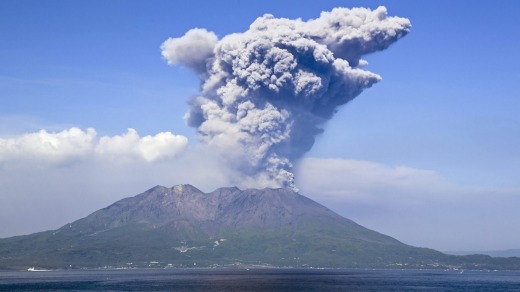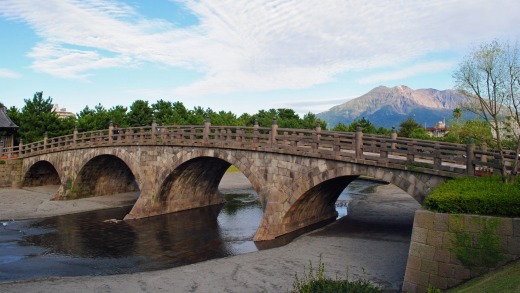
For some reason I scarcely notice the volcano at first. My Ponant ship has sailed into Kagoshima in the early morning, and perhaps I'm distracted by breakfast and map studying. I've opted out of an organised shore excursion, and take a tram into the city. Sleepy schoolkids hang on to straps and I can't see out of the window, but already I've taken to Kagoshima. Maybe it's the trams, the jaunty blue spring sky, the placid faces of housewives with their shopping baskets. Tram-stop names promise an exotic unknown: Korimoto, Shinyashiki, Izuro-dori.
Kagoshima is the deep south, far from Japan's smoggy grey conurbations. Its blue freshness reminds me of the Mediterranean. The graceful curve of its bay, culminating in Sakurajima volcano, could almost be the Bay of Naples. Alighting from the tram, I discover the city centre moves at a slow, southern pace quite different from the hurried clamour of Tokyo. Tenmonkan shopping street is pleasantly old-fashioned. Later in the day, locals sit in open-fronted eateries with clacking tongues and chopsticks, picking at grilled baby leeks and oysters in ginger broth.
I walk past the remains of Kagoshima castle, where giant orange carp gulp in the moat. I hop on a bus up Shiroyama Hill, which I'm told provides fine city views. And then: Boom! Taiwanese passengers scream in alarm. I peer out the bus window to see the volcano has erupted. The similarity to a nuclear mushroom cloud is unmistakable. Ash billows in the clear blue sky. I'm only reassured when I glance at two local women whose conversation doesn't even pause. For them, it's just another day living under the volcano.

On the hilltop I hurry off the bus and through the trees to the viewpoint. Beyond the crammed-in concrete of the city, the graceful bay is dotted with ferries and container ships. And finally, I'm taking notice of the volcano on the far side of the water. Its cone is textbook perfect, and a vast cloud of ash rises above.
Boom! More ash spews from its summit and an old man laughs as I jump. He speaks good English and tells me that the volcano coughs up smoke and ash almost daily. Its popping sometimes sends shockwaves across the city.
"It can hurt your ears, it's like taking off in an airplane," he says. "But how lucky you are that it rained yesterday, the trees look nice and green. And the wind is from the west, so the ash blows away from the city. When it comes from the east, oh, you must close up all your windows."

Now that the volcano has been brought so spectacularly to my attention there are signs of it everywhere. Black grit and ash sit in drifts at kerbsides. The black stonework of Kagoshima castle is formed from lava blocks. Notices everywhere in town indicate emergency evacuation routes, though their manga-like pictures make them seem cartoonish.
How do people living so close to disaster remain so calm? Why do they live here at all? True, there are some benefits to having a volcano on your doorstep. The fertile soil sprouts oranges, watermelons, huge daikon radishes and sweet potatoes used in a renowned local spirit. Volcanic ash provides a distinctive silvery sheen to local pottery, and the hot springs so beloved of the Japanese gush.
Then again, the last time the volcano exploded in 1914 it ejected 3 billion tonnes of lava. It has been rumbling for decades and has shown a significant increase in activity over the past few years. It belches ash four or five times daily, though locals think that might be a good thing. It's when the crater gets bottled up that you have to worry about "the big one", something that volcano-dwellers often talk about but never really think is going to happen.

Some locals live across the bay, at the foot of the fire mountain. I take the ferry across to Sakurajima whose name – Cherry Blossom Island – is cheerfully misleading. Ash drifts down like black snow but locals peg out their washing anyway. Emergency shelters are marked in yellow, and this is where you'd run to shelter from falling lava. I can feel the earth shiver beneath my feet. Scientists have raised the warning level and think a serious eruption is imminent.
I feel a profound unease and defiant exhilaration. Humans are hopeful creatures, never believing today will be the day, or that disaster will come knocking at their door. That's why I'm strolling about wiping ash off my glasses, and clogging my arteries with an unexpected black forest cake in a Sakurajima coffee shop. Besides, such closeness to an active volcano is a rare thrill, and 600,000 other people living in Kagoshima must feel the same way. Or perhaps they're just in denial.
The best place to admire the volcano (apart from the must-go of Shiroyama Hill) is from Sengan-en Villa, just out of town along the bay. Here, the volcano becomes part of the villa garden's "borrowed scenery" for which Japanese landscaping is noted. The bay is another pond and the mountain another hill melding into the garden's artificial hills, which are topped with stone lanterns and pine trees.
Sengan-en Villa belonged to the Shimadzu family who ruled over this region from 1185 until the demise of the samurai class in 1869. Somehow the Shimadzus dodged disaster for seven centuries, maybe helped by the bat-shaped nails that pin the villa's crossbeams; bats are a traditional symbol of good luck. Maybe they were inspired by one of their calligraphy scrolls and just didn't worry: "Harbour no evil thoughts," it commands in looping ink.
My tour of the villa ends in a tea ceremony. Dutifully, I admire the tea bowl, turn the rim and sip appreciatively at the gluggy green tea before returning the bowl to the tatami mat. I gaze out on a courtyard of raked gravel. Boom! The volcano has me flinching again, but my guide is unperturbed. She kneels in her tight kimono with an elegance learned from long practice, scoops up my tea bowl and sashays away through a sliding screen painted with cherry blossoms.
Outside, ash rises into the sky. The volcano has taken on a pinkish hue, and looks pretty as poetry in the evening sun.
www.kagoshima-yokanavi.jp/english
www.jnto.org.au
Japan Airlines flies from Melbourne and Sydney to Kagoshima via Tokyo. See www.au.jal.com
Ponant's "Best of Japan" cruise visits Kagoshima on its eight-night itineraries around southern Japan (and Pusan in Korea) between Maizuru and Osaka. Prices from $3780pp. See www.ponant.com
If you aren't cruising, stay at Shiroyama Kanko Hotel, which has great views over the town and smoking volcano and good hot spring baths. See www.shiroyama-g.co.jp